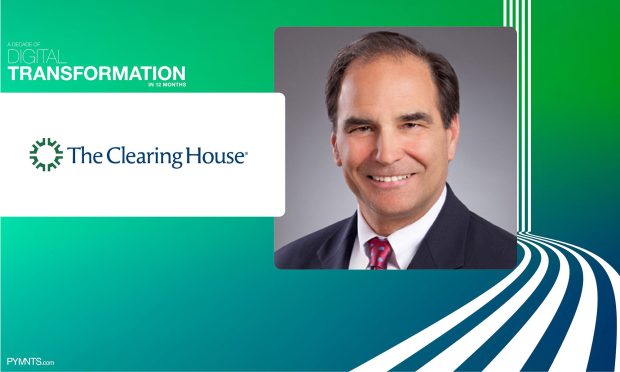Payment Changes Forced By The Pandemic Provide Businesses With Competitive Advantages

In A Decade of Digital Transformation in 12 Months, 46 C-suite executives spoke with PYMNTS for its Q2 eBook on what the world will look like as recovery rolls on and the next iteration of normal rolls out. In this excerpt, Jim Aramanda, CEO of The Clearing House, says he believes the shift to faster payments triggered by the pandemic will continue. “This desire for instant availability of funds is increasingly viewed as a competitive advantage by businesses, and faster payment systems provide this real-time capability,” he says.
Read the entire eBook here.
There is no question that the COVID-19 pandemic rapidly accelerated society’s shift to digital commerce, from shopping to banking to collaboration and, of course, to payments. In fact, digitization in all forms became the norm during the pandemic, instead of something that was previously considered as leading-edge.
The acceleration to digital in many instances was eye-opening. In the period of a few weeks in March and April 2020, most of the corporate world shifted to virtual offices and quickly adopted video conferencing, such as Zoom, Webex and Microsoft Teams, as well as other digital collaboration tools. Amazon and larger retailers saw a boom in online orders.
Other retailers, including many local businesses, quickly enhanced online purchasing capabilities – often with contactless delivery or pickup options – when stay-at-home orders shuttered many small businesses. And restaurants pivoted to online ordering for takeout and delivery, many times in partnership with gig economy companies such as Grubhub and Uber Eats.
Underpinning the shift to digital commerce was, and still is, the ability to make payments smoothly and efficiently. Prior to the pandemic, 75 percent of Americans favored online banking – but once pandemic restrictions set in, the number rose to 87 percent. This trend looks like it will remain, with only 6 percent of Americans planning to shift back to in-person banking now that the pandemic is winding down, and another study showing that 84 percent of consumers will maintain their digital banking habits even as financial institutions’ in-person operations normalize.
On the payments front, the shift to meet the growing needs of digital commerce accelerated the move to digital payments, a trend the industry has been seeing for a number of years. An Accenture report found that payments will see almost $7 trillion move from cash to digital payments by 2023, which will grow to $48 trillion by 2030.
The shift to faster payments since 2020 is something that will likely continue, and will outlast many of the pandemic trends we have witnessed. This desire for instant availability of funds is increasingly viewed as a competitive advantage by businesses, and faster payment systems provide this real-time capability.
For example, the RTP® network – the real-time payments network run by The Clearing House that offers 24/7 availability and simultaneous clearing and settlement with additional messaging capabilities – is seeing workers receive instant wage payouts at the end of every shift via DailyPay, while Paychex offers employers the ability to initiate real-time payroll payments at any time. This type of flexibility with payroll and earned wages offers retailers, restaurants and gig economy companies, such as Grubhub and Uber, a competitive advantage in the battle to attract workers and drivers from rivals.
